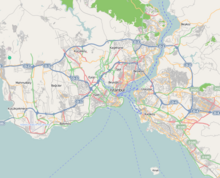Siege of Constantinople (1411)
This article has multiple issues. Please help improve it or discuss these issues on the talk page. (Learn how and when to remove these template messages)
|
| Siege of Constantinople | |||||||
|---|---|---|---|---|---|---|---|
| Part of the Byzantine-Ottoman wars. | |||||||
 Constantinople in 1422; the oldest surviving map of the city. | |||||||
| |||||||
| Belligerents | |||||||
|
|
| ||||||
| Commanders and leaders | |||||||
| Manuel II Palaiologos | Musa Çelebi | ||||||
Location within Istanbul | |||||||
The siege of Constantinople of 1411 occurred during the
Background
Before the Battle of Ankara, the Byzantine Empire was a mere pawn of outside forces for several decades but after the defeat of the Ottomans by Timur, the Empire – for a short while – became a player in Ottoman domestic politics and intrigue. Sultan Bayezid conquered much territories in Europe and threatened Constantinople from all directions.
The Byzantine Emperor
Despite defeating his brother and rival for the Ottoman throne, Musa, at the Battle of Kosmidion in June 1410, Süleyman's popularity waned. So much so, that when Musa returned to avenge his defeat during the following year, Süleyman's supporters defected to Musa.[3] Süleyman was captured while attempting to escape and was given to Musa's bodyguard, Koyun Musasi, and strangled to death on 17 February 1411.[4]
The siege
Musa found himself as the co-sultan of the European portion of the empire.[5] Musa then retaliated against all who allied with Süleyman, including Manuel II, by briefly and fruitlessly laying siege to Constantinople in 1411.[6][7] Manuel II turned to Mehmet for support, who betrayed Musa and set up a new alliance between himself and the Byzantines against Musa.
References
- ^ Dimitris J. Kastritsis, The Sons of Bayezid, (Brill, 2007), xi.
- ^ Fine, John Van Antwerp, The Late Medieval Balkans, (University of Michigan Press, 1994), 499.
- ^ Wittek, Paul. Rise of the Ottoman Empire. p. 150.
- ^ Kastritsis 2007, p. 155-156.
- ^ Prof. Yaşar Yüce-Prof. Ali Sevim: Türkiye tarihi Cilt II, AKDTYKTTK Yayınları, İstanbul, 1991 p 74-75
- ^ Imber 2002, p. 14.
- ^ Ostrogorsky 1969, p. 557.
Sources
- ISBN 978-0-3336-1386-3.
- Kastritsis, Dimitris J. (2007). The Sons of Bayezid: Empire building and representation in the Ottoman Civil War of 1402-13. Brill.
- Ostrogorsky, G. (1969). History of the Byzantine State. Rutgers University Press.



